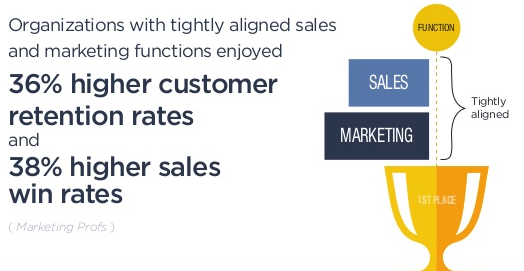Aligning your sales and marketing teams is one of the easiest ways to grow your business.
In most companies, marketing and sales teams don’t collaborate very efficiently. But that shouldn’t be the case. After all, they’re both trying to help the company grow, right?
The only difference is that they try to achieve this goal in different ways. While your marketing team tries to raise awareness about your brand and generate leads, your sales team aims to close deals.
Download our Business Resource – Sales and marketing integration guide
This guide will give you practical recommendations, based on real-world examples, showing how to get your sales and marketing teams working together more effectively.
Access the Sales and marketing integration guide
In the end, they’re essentially working towards the same thing. This is why getting them to work together can do wonders for your company’s growth.
You’ll see:
- Lowered sales costs.
- More cost-efficient marketing.
- Shortened sales cycles.
- Increased conversions.
Here’s how to get these departments on the same page and grow your business instantly.

Establish processes
Setting up clear-cut processes for interdepartmental collaboration is one of the easiest ways to get your sales and marketing teams to work together. Here’s how:
1. Make sales a marketing metric
One of the easiest ways to align your sales and marketing teams is by making sales a marketing metric. As your marketing team is now mandated to track sales as a performance indicator, they’ll have to collaborate more closely with your sales team.
Some of the most successful teams track sales as a key marketing metric for their content marketing activities. Companies like CultureAmp, Sandler Training and IBM all use sales as key metrics to determine their marketing success.
2. Get sales and marketing teams to collaborate in hiring
Another simple way to get your sales and marketing teams to work together is by including them in each other’s hiring processes. For example, you can include senior sales team members in your hiring process when building an SEO team.
Why is this helpful? For two reasons.
First, sales leaders will give you a different perspective to evaluate each candidate.
Even if they don’t know much about SEO, they certainly know a lot about analyzing customer needs. Therefore, they will be in a position to determine if SEO candidates have the capacity to understand customers sufficiently well. After all, understanding customer needs is an essential skill for SEO factors like judging search intent, doing persona-based keyword research, SEO copywriting, etc.
Additionally, adding department representatives to your hiring process makes interdepartmental collaboration easier. As each department took an active role in assembling the teams, they’ll find it easier to work together.
3. Build processes to qualify leads
Sales and marketing teams frequently disagree on the definition of a ‘qualified’ lead. Your sales reps should only reach out to leads who are primed for a sales pitch. But how do they know when a lead is ready?
Through your marketing team’s data.
Establish a process for your marketing team to qualify your leads. They can monitor a lead’s buyers journey through your website and content to determine what funnel stage they’re in. For example, signing up for a newsletter is a sign of interest - but it’s still too early for a pitch. However, viewing a product video entirely is a good sign that they’re ready to be contacted.
This way, your sales reps will only reach out to leads primed for sales pitches - saving them tons of time and effort.
4. Use marketing insights for more efficient sales meetings
Your sales reps need to know everything about a lead before approaching them. They should know their challenges, what they’re looking for, their company’s background - everything. All this information will help your reps efficiently prep for their sales meetings.
Remember, your prospects aren’t always going to clearly express what they want; your reps will have to figure it out.
To help them stay informed, establish a process whereby your marketing team conveys lead-related information to your sales team. For example, your content team can use tools like Google Analytics to track what a lead is interested in before you approach them.
Say your product is a CRM and your prospect is spending tons of time on your integrations pages. Your marketing team can convey this information to your sales reps to help them structure their meeting around this feature. This way, they’re directly addressing a customer’s needs - boosting their chances of a conversion and cutting down meeting time.
5. Use sales insights to shape your marketing strategy
Your marketing team is always on the lookout for more information about your customer’s wants and needs. The logic is simple - know what your customer wants and craft marketing strategies around those wants.
And who better to convey these customer insights than your sales team?
As they interact with leads everyday, they’ll be able to pick up what they really need. Your sales team can have periodic meetings with your marketing team to convey information that’ll help shape your marketing tactics.
For example, if sales reps realize that your target audience prioritizes customer service - your marketing team can begin to launch campaigns centered around your excellent customer support. This is going to help you create cost-effective marketing campaigns that directly address customer concerns.
6. Customize marketing follow-ups with sales insights
Your lead nurturing process doesn’t end with a sales meeting. Usually, that’s just the beginning; it’s going to take multiple follow-ups to close that lead eventually.
It’s important to get these follow-ups right.
Remember, the kind of marketing emails a lead receives after a sales meeting will differ from the ones they received earlier.
Create a process where your sales reps relay all their insights about a lead to your marketing team. They can highlight information from the meeting surrounding the lead’s likes, dislikes and concerns.
Your marketing team can then structure subsequent newsletters for each lead to align with this new information. For example, if your salespeople see during a particular month that prospects have questions about GDPR compliance, your marketing team can tweak their newsletter to send GDPR-related posts. This way, your leads will only be receiving targeted, relevant follow-ups - increasing their chances of converting.
Communicate
The easiest way to get any two parties on the same page is to let them communicate with each other. Having group meetings with your sales and marketing departments is an easy way to iron out differences and address concerns quickly.
Here’s what you can do during these meetings:
1. Develop buyer personas together
Your sales and marketing teams are working towards attracting people to your company.
Make sure it’s the right people.
Get your marketing and sales teams together and jointly go over customer challenges, needs and wants. This will help create standard buyer personas that both teams will be familiar with.
This will make marketing-to-sales handoffs easy as your marketing tactics have primed your customers for your sales approach.
2. Identify friction points in your sales funnel
Most interdepartmental conflict is caused by misunderstandings over responsibilities. To avoid this happening, let each department highlight what they think your sales funnel looks like. There’s going to be some glaring differences between what your sales team perceives and what your marketing team thinks.
Now, it’s up to you to outline what your sales funnel actually looks like.
Illustrate what each department is responsible for and highlight how both departments can collaborate to smoothen this process. As you’re clearly outlining each department’s responsibilities, you’ll face fewer friction points where departments are confused about their roles.
3. Collaborate on strategies
The best way to unify both departments is by including them in your strategic planning. Let each department give their inputs to create a strategy that satisfies both parties. Not only does this help create a compromise that everyone’s happy with, it also builds empathy.
These brainstorming sessions expose people to concerns and issues that they didn’t know existed. With this knowledge, your departments will find easier to understand where other departments are coming from and why these are valid issues.
Final thoughts
Sales and marketing alignment is one of the easiest ways for companies to supercharge their growth.
All it takes is a few processes and some efficient communication to get them on the same page. Once you do that, you’ll instantly save time and boost your conversions.
Vaishali Badgujar is a content marketer at
Time Doctor, a SaaS time tracking & productivity tool for companies & freelancers. She is a content marketing expert & specializes in link building. Follow her on
Twitter or connect on
LinkedIn.









